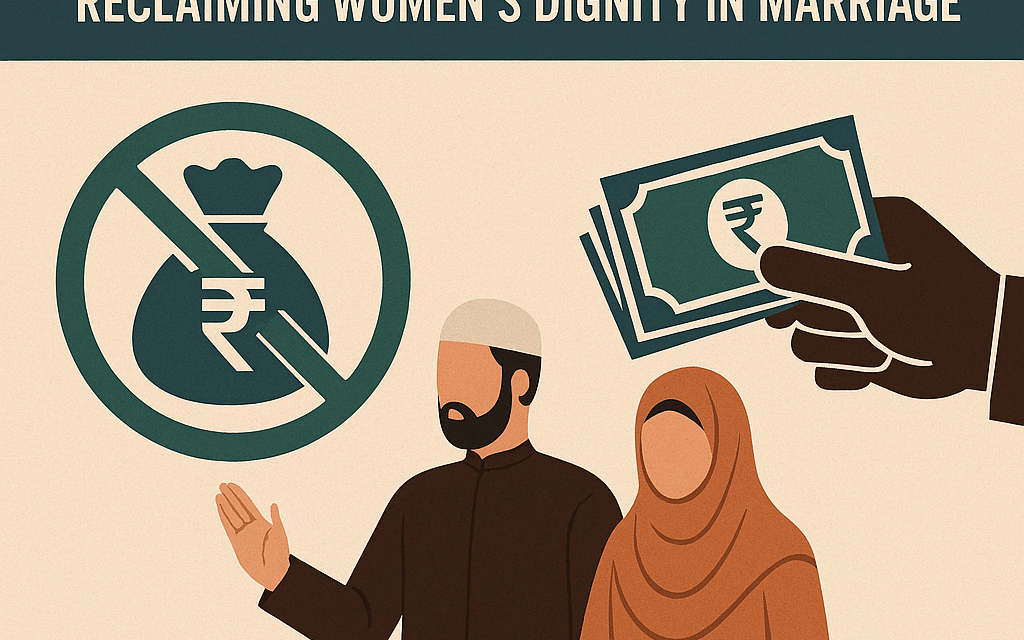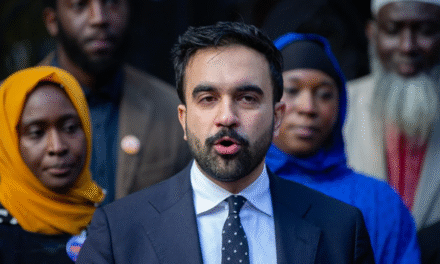~ Dr. Uzma Khatoon
Every day in India, the dowry system continues to claim lives and destroy families. One recent case involved a young woman named Nikki, who was burned alive by her husband’s family because they were dissatisfied with the dowry given. Such tragedies are not rare; according to the National Crime Records Bureau, thousands of dowry deaths are reported every year. These stories expose the dark reality of a practice that has moved far away from its original purpose and turned into an instrument of greed, oppression, and violence.
Dowry means the money, property, or gifts a bride brings to her marriage. Traditionally, it was considered a gift from the bride’s family to help her start her new life. In legal terms, dowry includes anything of value demanded or exchanged at marriage, while voluntary gifts are not counted. In today’s society, dowries usually take the form of cash, jewelry, or household appliances. Because women often face barriers in inheriting family property, dowry is sometimes justified as a daughter’s share of family wealth given before her parents pass away.
Originally, dowry was meant to secure the bride’s welfare, but in practice, it has become a source of power for the groom’s family. What was once voluntary has become an obligation, often enforced by threats or pressure. Poor families fall into debt trying to meet rising demands, and daughters are reduced to bargaining chips in a marriage market. Instead of protecting women, dowry has become one of the strongest causes of their exploitation.
Defenders of dowry argue that it provides women with wealth, raises a family’s social standing, or ensures good marriage prospects. Yet the reality is very different. Most of the items given as dowry—cash, clothes, jewelry—rarely remain under the woman’s control. They quickly become part of the husband’s household, offering the bride little independence or security. Instead of empowering her, dowry reinforces her dependence.
The consequences are severe. Dowry fuels the idea that daughters are a burden and sons an investment. It pressures families into extravagant spending and creates fertile ground for corruption, as police and courts often mishandle cases of dowry harassment or deaths. It encourages consumerism and caste-based pride, reducing marriage to a financial deal instead of a sacred union.

For many women, the results are deadly. When families cannot meet demands, brides are harassed, tortured, or even killed. In India, official records still show nearly 6,000 dowry deaths reported each year, though the real number is believed to be higher due to underreporting. Behind each number is a daughter, a wife, and often a mother whose life was cut short by greed.
In this system, brides have little say in negotiations. They are treated as objects in an exchange, their worth measured by how much dowry they bring. The cruelty sometimes extends beyond the husband to mothers-in-law and sisters-in-law, who participate in harassment. Women are trapped in a cycle where they oppress other women, continuing traditions of exploitation.
Cultural and religious beliefs have also supported inequality. In some traditions, women are seen as dependent on fathers, husbands, and sons. Marriage is considered the only path to social respect or spiritual fulfillment. Stories and rituals have idealized the obedient wife who sacrifices everything for her husband, even her life. These ideas have normalized women’s subordination for generations.
What began as voluntary gifts has turned into endless extortion. Families are forced to keep giving even after the wedding. If they fail, brides face violence or death. In the 1980s, news of dowry deaths shocked the nation, and sadly, similar reports continue today. New brides, sometimes even pregnant, are among the victims. Families unable to meet demands live in fear, watching helplessly as their daughters suffer.
To fight this, the Dowry Prohibition Act was passed in 1961 and later strengthened. On paper, giving or receiving dowry is illegal. But in practice, the law has had limited success. Families hesitate to report cases, fearing social stigma. Police and courts often dismiss victims’ complaints, and corruption weakens enforcement. Many women named their abusers before dying, yet courts refused to accept their statements as valid evidence. Justice remains rare.
Dowry survives because it is tied to deep social beliefs, male dominance, and caste divisions. Like the old practice of sati, where widows were forced to die with their husbands, dowry deaths reflect a society that measures a woman’s worth in terms of wealth. Until traditions, laws, and attitudes change fundamentally, dowry will remain a tool of exploitation.
Education is often seen as a solution, and it does play a role. It raises awareness, promotes gender equality, and builds women’s confidence. Activists have worked on revising textbooks, training teachers, and running awareness campaigns. But education is not enough on its own. Social pressures, family honor, and community traditions often outweigh what schools teach.
Ironically, education sometimes increases dowry demands. A well-educated girl is expected to bring a larger dowry to match her groom’s education level. Families may spend more on dowry than on their daughter’s schooling, treating both as expenses rather than investments. Girls who study beyond a certain level face reduced marriage options, as many men refuse brides who are “too educated.” This discourages education and leads to higher dropout rates for girls.
The dowry problem is deeply connected to culture, caste, religion, and economic structures. It is not just an Indian issue but a global concern wherever women are treated as property. International support, awareness campaigns, and women’s movements have highlighted the cruelty of dowry, but meaningful change must come from within society.
From an Islamic perspective, the dowry system as practiced today is completely un-Islamic. Islam emphasizes marriage as a sacred contract based on mutual respect and consent. Women are not seen as burdens, and raising daughters with love is considered a noble act. In Islam, marriage begins with Nikah, a contract agreed upon freely by both bride and groom. A woman forced into marriage has the right to reject it. Marriage is meant for companionship, support, and building a family, not for financial transactions.
At the heart of Islamic marriage is Mahr, a mandatory gift given by the groom to the bride. Unlike dowry, Mahr belongs fully to the woman as her right and cannot be taken back. It provides security and respect. The Prophet Muhammad (peace be upon him) gave Mahr to his wives and encouraged simplicity in marriage. When his daughter Fatima married, the gifts exchanged were modest and symbolic, showing that marriage should not be a burden.
Unfortunately, in India, dowry customs have spread even among Muslims, despite Islamic teachings. What should be voluntary gifts have become demands, with amounts depending on the groom’s education and status. Poor Muslim families also suffer under this system, and cases of harassment and dowry deaths are reported in states like Bihar and Uttar Pradesh. This shows how cultural practices can overshadow religion.
To change this, reform must come from within. Muslim communities must return to the principles of Islam, which reject dowry and promote equality. Women should be made aware of their rights, and men must be held accountable to honor Mahr and provide support. Inheritance and property must be given an islamic way. Education and economic independence for women are crucial in resisting exploitation. By following the Prophet’s example of simplicity and fairness, Muslims can lead by example in rejecting dowry.
The history of dowry also shows how it developed differently across societies. In ancient times, dowry was common in Europe and Asia, often given as a daughter’s share of family wealth. But as societies modernized, dowry declined. In many Western countries, equal inheritance rights and better education replaced the practice. In Greece, dowry traditions are fading with urbanization and changing gender roles.
India is unusual because dowry has grown stronger in recent decades instead of disappearing. Two key reasons explain this: rapid population growth has created a “marriage squeeze,” and families seek upward mobility through marrying daughters to higher-status men, known as hypergamy. Educated, urban men with stable incomes are rare, so families compete by offering larger dowries. This has led to dowry inflation, even in cities.
Some scholars believe that with urbanization, women’s education, and shrinking rural-urban divides, dowry may eventually decline in India too. But this will take time. For now, dowry reflects the larger reality of inequality: daughters moving to their husband’s homes while sons remain with parents to inherit wealth. As long as this structure remains, dowry will continue.
To end dowry, society needs more than laws. It requires social reform, education, and community action. Women must have equal rights to inheritance and property, reducing the need for dowry as compensation. Families should reject lavish weddings and gifts, choosing simplicity. Religious and community leaders should speak out clearly against the practice. Schools must teach gender equality from an early age, shaping the next generation to value women as individuals, not commodities.
Most importantly, women need economic independence. When women can earn, own property, and make choices, they are less vulnerable to exploitation. Empowerment through education and employment is the strongest weapon against dowry.
In conclusion, dowry is not just a marriage custom—it is a symbol of inequality, greed, and oppression. It destroys lives, weakens families, and dishonors the sacred meaning of marriage. While laws exist, they cannot succeed without social change. By combining education, reform, equal rights, and empowerment, India can move toward a society where marriage is based on dignity and love, not financial deals. For Muslims, returning to true Islamic principles of Mahr and simplicity can show the way forward. Only then can dowry be truly abolished, and women be given the respect and equality they deserve.
Dr.Uzma Khatoon has taught in the Department of Islamic Studies at Aligarh Muslim University





